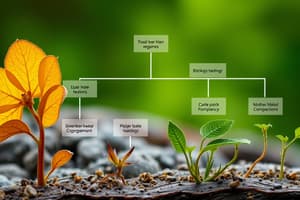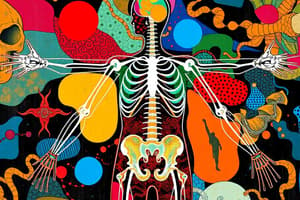Podcast
Questions and Answers
What is the function of the Endocrine System?
What is the function of the Endocrine System?
- Maintain internal conditions in the body (correct)
- Facilitate physical movement
- Provide structural support for the body
- Defend the body against infections
Natural Selection is based on Charles Darwin's theory.
Natural Selection is based on Charles Darwin's theory.
True (A)
In Lamarck's theory, what organ is believed to develop if your peripheral nervous system is damaged?
In Lamarck's theory, what organ is believed to develop if your peripheral nervous system is damaged?
limb
The excretory system removes excess and waste products from the body. The part that removes alcohol from the blood is the __________.
The excretory system removes excess and waste products from the body. The part that removes alcohol from the blood is the __________.
Match the following components with their functions in Photosynthesis:
Match the following components with their functions in Photosynthesis:
What is the primary function of the Immune System?
What is the primary function of the Immune System?
Flashcards
Endocrine System
Endocrine System
System of glands releasing hormones to maintain internal balance (homeostasis).
Circulatory System
Circulatory System
System with heart, blood vessels, and blood to transport nutrients and remove waste.
Photosynthesis
Photosynthesis
Plants converting light energy to chemical energy (glucose).
ATP (energy)
ATP (energy)
Signup and view all the flashcards
Natural Selection
Natural Selection
Signup and view all the flashcards
Sexual Reproduction
Sexual Reproduction
Signup and view all the flashcards
Study Notes
Endocrine System
- Comprises all internal glands that release hormones
- Maintains homeostasis, a state of equal internal condition, in living organisms
Circulatory System
- Includes heart, blood vessels, and blood circulating throughout the entire body
- Types:
- Open circulatory system (found in arthropods)
- Closed circulatory system (found in humans)
Excretory System
- Removes excess and waste products from the body
- Organs involved:
- Liver (removes alcohol from blood)
- Kidney (removes toxins)
Evolution and Natural Selection
- Evolution produces new species
- Environmental forces like natural disasters can cause extinction
- Natural Selection (Charles Darwin's theory):
- Offspring with favorable characteristics survive and have more offspring
- Use and Disuse (Lamarck's theory):
- Organs develop as a result of environmental need
- Acquired traits are not inherited through DNA
Reproduction
- Sexual Reproduction:
- Involves production of separate male and female gametes
- Found in plants (e.g., flowers)
- Asexual Reproduction:
- Produces genetically identical individuals
- Found in plants (e.g., roots, stolons, and bulbs)
Photosynthesis
- Occurs in chloroplasts
- Transforms light energy into chemical energy
- Requires water, carbon dioxide, and light to produce glucose and oxygen
- Has two parts:
- Light-dependent reaction (thylakoid)
- Light-independent reaction (Calvin Cycle)
Energy Production
- ATP (Adenosine Triphosphate): 3 phosphate groups
- ADP (Adenosine Diphosphate): 2 phosphate groups
- 34 ATP produced using 2 electrons
Plant Structure
- Leaves have xylem and tiny cellular projections called villi
- Stem has lenticel for gas exchange from the atmosphere
Organ Systems
- Skeletal System: internal framework and structural support
- Muscular System: facilitates physical movement
- Integumentary System: outermost layer of human and animal bodies (includes nails, hair, and skin)
- Immune System: defends the body against infection and destroys microorganisms
Studying That Suits You
Use AI to generate personalized quizzes and flashcards to suit your learning preferences.




